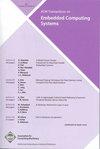使用通用语言构建可验证的CPS
IF 2.6
3区 计算机科学
Q2 COMPUTER SCIENCE, HARDWARE & ARCHITECTURE
引用次数: 0
摘要
网络物理系统(CPS)的正式验证具有挑战性,因为它必须考虑在普通软件中经常缺失的实时和并发性方面。此外,CPS中的软件通常是复杂和低级的,这使得很难保证用于验证的系统的正式模型是实际实现的忠实表示,这可能会破坏验证结果的价值。为了解决这个问题,我们提出了一种构建可验证的CPS的方法,该方法基于软件的正式模型可以从其实现中自动导出的原则。我们的方法要求系统实现用Lingua Franca (LF)指定,这是一种为实时、并发CPS量身定制的多语言协调语言,我们通过代码中的注释使其符合安全属性的规范。LF的程序结构和确定性语义使得直接从LF程序自动构造形式化公理模型成为可能。生成的模型由验证引擎Uclid5使用Z3 SMT求解器自动使用BMC (Bounded Model Checking)进行检查。所提出的技术能够检查定义良好的安全度量时间逻辑(Safety MTL)公式片段。为了保证BMC的完备性,我们提出了一种基于LF语义的公理模型完备性阈值上界的推导方法。我们在LF V验证器中实现了我们的方法,并使用一个包含22个程序的基准测试套件来评估它,这些程序来自于现实生活中的应用程序和Erlang、Lustre、面向角色的语言和rtos的基准测试。LF V验证器自动正确检查22个程序中的21个。本文章由计算机程序翻译,如有差异,请以英文原文为准。
Towards Building Verifiable CPS using Lingua Franca
Formal verification of cyber-physical systems (CPS) is challenging because it has to consider real-time and concurrency aspects that are often absent in ordinary software. Moreover, the software in CPS is often complex and low-level, making it hard to assure that a formal model of the system used for verification is a faithful representation of the actual implementation, which can undermine the value of a verification result. To address this problem, we propose a methodology for building verifiable CPS based on the principle that a formal model of the software can be derived automatically from its implementation. Our approach requires that the system implementation is specified in Lingua Franca (LF), a polyglot coordination language tailored for real-time, concurrent CPS, which we made amenable to the specification of safety properties via annotations in the code. The program structure and the deterministic semantics of LF enable automatic construction of formal axiomatic models directly from LF programs. The generated models are automatically checked using Bounded Model Checking (BMC) by the verification engine Uclid5 using the Z3 SMT solver. The proposed technique enables checking a well-defined fragment of Safety Metric Temporal Logic (Safety MTL) formulas. To ensure the completeness of BMC, we present a method to derive an upper bound on the completeness threshold of an axiomatic model based on the semantics of LF. We implement our approach in the LF V erifier and evaluate it using a benchmark suite with 22 programs sampled from real-life applications and benchmarks for Erlang, Lustre, actor-oriented languages, and RTOSes. The LF V erifier correctly checks 21 out of 22 programs automatically.
求助全文
通过发布文献求助,成功后即可免费获取论文全文。
去求助
来源期刊

ACM Transactions on Embedded Computing Systems
工程技术-计算机:软件工程
CiteScore
3.70
自引率
0.00%
发文量
138
审稿时长
6 months
期刊介绍:
The design of embedded computing systems, both the software and hardware, increasingly relies on sophisticated algorithms, analytical models, and methodologies. ACM Transactions on Embedded Computing Systems (TECS) aims to present the leading work relating to the analysis, design, behavior, and experience with embedded computing systems.
 求助内容:
求助内容: 应助结果提醒方式:
应助结果提醒方式:


